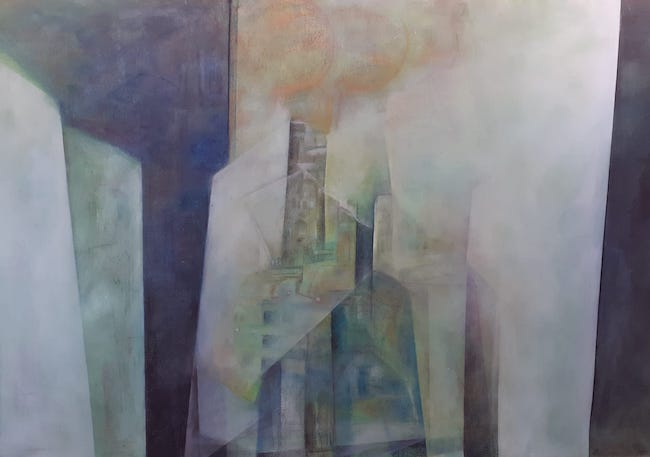L’arte contemporanea ha il privilegio di poter attingere a tutte le esperienze e le sperimentazioni del passato, in particolar modo di quel vivace e dinamico periodo costituito dal secolo scorso, consentendo perciò agli artisti di oggi di esplorare, personalizzare e armonizzare alla propria indole e al proprio istinto espressivo tutto ciò che di quel passato è ispirazione per elaborare un personale e distinguibile linguaggio pittorico o scultoreo. La sensibilità di alcuni creativi li induce a tendere verso una rarefazione delle immagini, funzionale ad approfondire e liberare sensazioni inconsce che diversamente, se eccessivamente legate all’osservato, rimarrebbero imbrigliate nelle pieghe della razionalità. La protagonista di oggi elabora, scegliendo il distacco dalla realtà oggettiva, una cifra pittorica melodica e delicata, dando una personale interpretazione sul ventaglio di sensazioni e di concetti che appartengono all’interiorità umana.
Nel corso dei primi decenni del Ventesimo secolo si è verificata, oltre che una profonda rottura con le regole che avevano dominato l’arte precedente fino alla fine dell’Ottocento, anche una spaccatura, una divisione tra gli artisti orientati alla scomposizione dell’immagine e al distacco dalla realtà, così come dalla soggettività, e quelli che invece avevano bisogno di restare legati al visibile pur stravolgendone l’aspetto per adeguarlo al sentire interiore, trasformando pertanto ogni dettaglio in riflessione dell’emozionalità. Da un lato dunque il Cubismo e il Futurismo che frammentando le immagini compivano una ricerca quasi analitica sulla modalità di riproduzione del senso di contemporaneità temporale attraverso la rinuncia alla terza dimensione e proponendo una visione simultanea di tutte angolazioni dell’osservato, oppure sulla reiterazione della suddivisione per infondere allo sguardo del fruitore la sensazione di velocità e di progresso affine all’evolversi rapido dei tempi moderni; dall’altro l’Espressionismo e il Surrealismo che mettevano in primo piano le emozioni e il sentire intimo dell’autore dell’opera o le angosce mentali, gli incubi e la dimensione onirica che dominavano il mondo inconscio dell’essere umano. La tendenza alla scomposizione iniziata con Pablo Picasso e Georges Braque venne poi estremizzata da tutti quei movimenti astratti e informali che si allontanarono ancor più dall’interpretazione emotiva, come il Neoplasticismo, il Suprematismo e l’Astrattismo Geometrico, da cui trassero ispirazione anche i coniugi Robert e Sonia Delaunay, fondatori del Cubismo Orfico dove la frammentazione fu talmente estremizzata, e i colori resi molto più vivi rispetto a quelli terrosi e sfumati utilizzati da Picasso e da Braque, da divenire Astrattismo; in tutti questi casi però ciò che venne a mancare fu la soggettivizzazione, il coinvolgimento emozionale da parte degli autori delle opere. Per superare questa sconnessione dal sentire dell’artista, che fu linea guida dell’Espressionismo, pura sensazione, e dell’Astrattismo Lirico di Vassily Kandinsky, nacque negli Stati Uniti un movimento che si propose di unire queste due forme espressive dando vita all’Espressionismo Astratto, una dimensione dove la non forma, l’affrancamento da ogni tipo di immagine reale e persino di struttura geometrica, si apriva alla spinta interpretativa e percettiva del singolo autore che dunque diveniva assolutamente libero di irradiare le tele di quelle profondità interiori che finalmente potevano trovare il loro spazio vitale all’interno di una corrente pittorica innovativa e coinvolgente anche per l’osservatore. Anticipatore di questo movimento fu Lyonel Feininger il quale, a seguito di variegate esperienze pittoriche, elaborò infine un Cubismo soffuso, delicato e costituito da trasparenze che tendono verso l’onirico da cui sembra trarre ispirazione l’artista altoatesina Daniela Armani la quale reinterpreta la traccia di Feininger sulla base di una sua personale scelta cromatica e di riadattamento della geometricità cubista all’impalpabilità morbida di un’interiorità che ha bisogno del dissolvimento dell’osservato per riuscire a compiere la giusta riflessione sui temi e sulle sensazioni che di volta in volta vengono resi protagonisti.
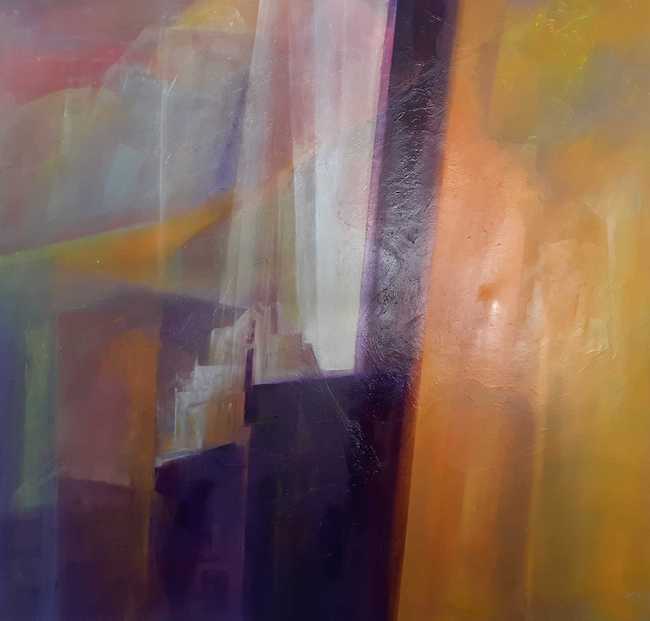
Le tele di Daniela Armani sembrano essere appunti di approfondimento, i titoli descrivono lo spunto dal quale è partita per compiere quell’analisi che l’ha indotta poi a lasciar fuoriuscire la propria emozione, ma anche il proprio punto di vista, sull’opera; i suoi dipinti sono aperti, concedono spazio interpretativo all’osservatore nella consapevolezza che non possa esistere una sola verità e che pertanto la sua rappresentazione debba essere altrettanto onirica, sfuggente, a volte misteriosa, esattamente come le velature che sembrano sovrapposizioni di differenti strati di possibilità, di opzioni tutte ugualmente valide che possono adattarsi alla soggettivizzazione se solo, come davanti a un prisma, si spostasse il punto di vista.
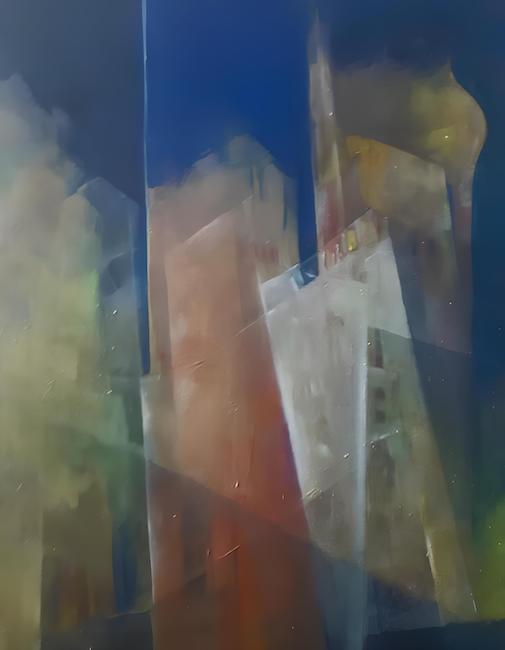
Ecco, nel caso di Daniela Armani si ha la sensazione di trovarsi davanti a un’elegia leggera ed empatica che, pur nella coscienza della sua staticità, infonde la sensazione che da un momento all’altro tutto possa muoversi per cambiare il suo aspetto e mostrare altri aspetti di quell’impressione. In virtù di questa tendenza la scelta del mezzo pittorico non poteva che essere l’olio, perché la sua asciugatura lenta consente alla Armani di riprendere il colore, di modificarlo, di plasmarne la struttura fino a quando il risultato finale non sarà quello più affine al suo sentire.
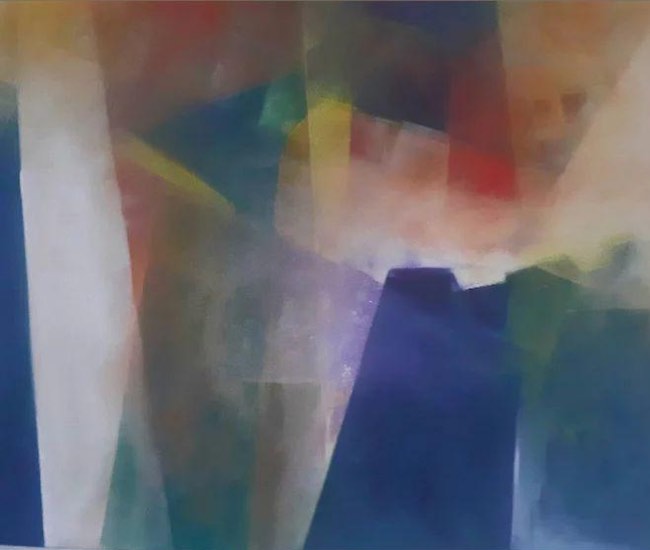
L’opera Controluce è simbolica di questo tipo di approccio artistico poiché la dimensione soffusa che pervade l’intera tela esprime tutta la poeticità che emerge dalle figure solo vagamente intuibili, come se in questo caso l’illusione visiva dovesse essere più marcata accentuando così il senso di relatività di tutto ciò che esiste e che assume tinte e connotazioni differenti a seconda di chi sia l’osservante; l’indefinitezza diviene così metafora dell’individualità che solo in un’accezione ha un significato negativo, ma per il resto sottolinea semplicemente la potenzialità del singolo di avere la propria visione, di farsi la propria idea o di restare fortemente legato alle proprie emozioni suscitate dalle circostanze, dalla realtà che lo circonda.
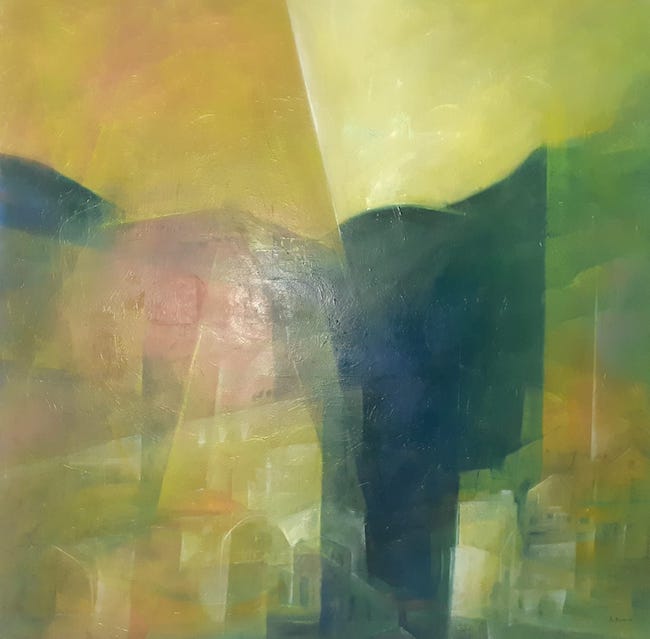
Nel dipinto La risalita la gamma cromatica si armonizza con il senso di positività, di speranza e di coraggio richiesto nel momento in cui l’essere umano cade e sa di doversi rialzare, di dover percorrere la scalata verso il punto precedente per non soccombere agli accadimenti; il verde e il giallo che dominano in varie sfumature la composizione, sottolineano quella necessità di avere un atteggiamento positivo, di non fermarsi all’ostacolo bensì di trovare una soluzione, un punto da cui aggirarlo e ricominciare a camminare più spediti e sicuri di prima. Anche in questo caso la sovrapposizione rappresenta i differenti atteggiamenti che ciascun individuo può avere, le molteplici reazioni per raggiungere l’obiettivo di risalire, che fanno della soggettività e del relativismo il punto focale della produzione pittorica di Daniela Armani.
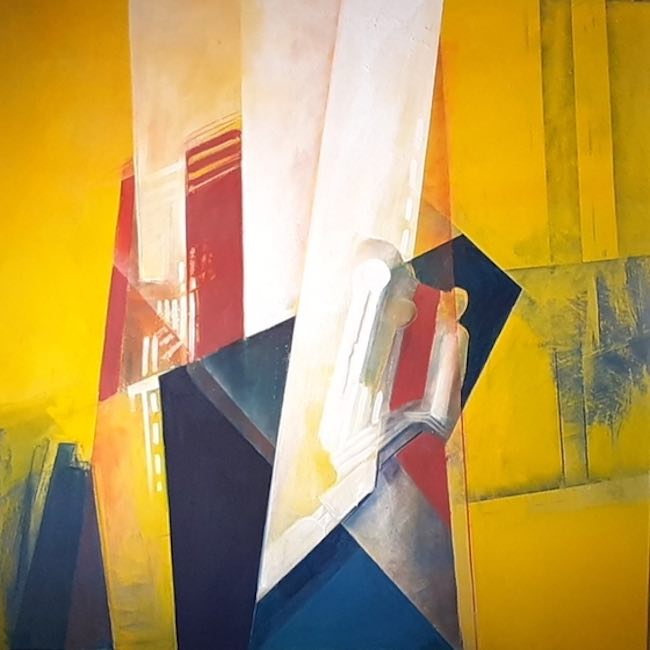
In Ti osservo però, l’artista sembra voler mettere in luce un distacco tra sensazione percepita e dunque interiore, e lo sguardo sull’oggettività, sul sentire al di fuori di sé, dove pertanto ciò che appare può solo essere guardato, compreso nella sua manifestazione spontanea, senza tentare di modificare l’essenza di un vissuto che può solo essere accolto; emerge pertanto un altro aspetto della personalità artistica, quanto interiore, di Daniela Armani, quello cioè di porsi in alcuni casi come pura ascoltatrice dello svolgersi delle circostanze, senza aggiungere la propria voce interpretativa bensì mettendosi in una posizione esterna da cui comprendere le sfaccettature dell’altro o di se stessa.
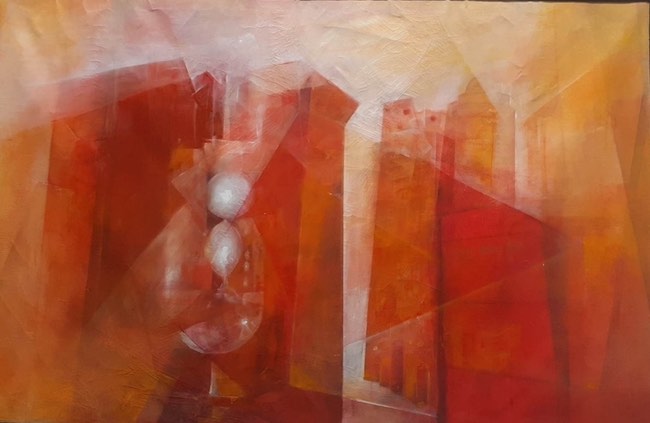
Questo è il motivo per il quale le linee sono più nette, si avvicinano di più al Cubismo a cui però sfugge, come d’altronde in tutte le opere della Armani, la figurazione che resta sempre in secondo piano rispetto all’importanza della comprensione a un livello più alto, quello del sentire, seppure in alcune opere, come in Perle nascoste, l’artista scelga di lasciar intravedere in modo più chiaro l’oggetto espresso dal titolo, nel caso specifico le perle appunto, come a voler mettere l’accento proprio su quanto molto spesso alcuni doni, che siano reali o spirituali, non vengano visti e valutati per il loro vero valore.
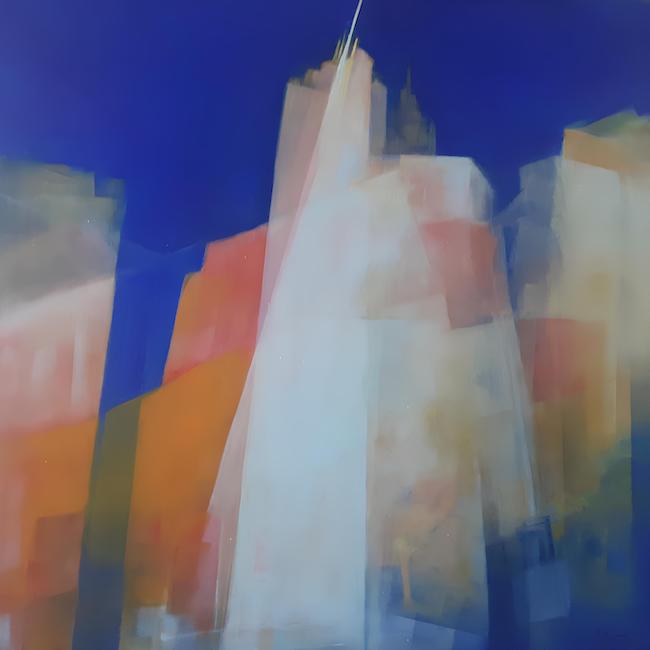
Daniela Armani dipinge da ventitré anni e nel corso di tutto questo tempo si è misurata con diversi mezzi come l’acquarello, l’acrilico, la tecnica mista, fino però a scegliere di stabilizzarsi sull’olio, più affine alla sua natura espressiva; ha al suo attivo la partecipazione a molte mostre collettive e anche l’organizzazione di diverse esposizioni personali, su tutto il territorio nazionale e fa parte dell’Associazione Artisti di Bolzano.
DANIELA ARMANI-CONTATTI
Email: daniela.armani@email.it
Facebook: www.facebook.com/daniela.armani.98
Instagram: www.instagram.com/daniela.armani.art/
Daniela Armani’s expressive elegy, between cubist reminiscences and slight figurations hiding in the transparencies of Informal Art
Contemporary art has the privilege of being able to draw on all the experiences and experiments of the past, especially that lively and dynamic period constituted by the last century, thus allowing today’s artists to explore, personalise and harmonise with their own nature and expressive instincts all that is an inspiration from that past to elaborate a personal and distinguishable pictorial or sculptural language. The sensitivity of some creatives induces them to tend towards a rarefaction of images, functional to deepen and release unconscious sensations that otherwise, if excessively tied to the observed, would remain trapped in the folds of rationality. Today’s protagonist, by choosing to detach herself from objective reality, elaborates a melodic and delicate pictorial style, giving a personal interpretation of the range of sensations and concepts that belong to human interiority.
During the first decades of the 20th century, there was not only a profound break with the rules that had dominated previous art until the end of the 19th century, but also a split, a division between those artists who were oriented towards the decomposition of the image and detachment from reality, as well as subjectivity, and those who instead needed to remain tied to the visible while distorting its appearance to adapt it to the inner feeling, thus transforming every detail into a reflection of emotionality. On the one hand, therefore, Cubism and Futurism, which by fragmenting the images carried out an almost analytical research on how to reproduce the sense of temporal contemporaneity by renouncing the third dimension and proposing a simultaneous vision of all angles of the observed, or on the reiteration of the subdivision to instil in the viewer’s gaze the sensation of speed and progress akin to the rapid evolution of modern times; on the other, Expressionism and Surrealism, which emphasised the emotions and intimate feelings of the author of the artwork or the mental anguish, nightmares and dreamlike dimension that dominated the unconscious world of the human being. The tendency towards decomposition that began with Pablo Picasso and Georges Braque was then taken to extremes by all those abstract and informal movements that moved even further away from emotional interpretation, such as Neoplasticism, Suprematism and Geometric Abstractionism, from which also drew inspiration Robert and Sonia Delaunay, founders of Orphic Cubism where the fragmentation was so extreme, and the colours made so much more vivid than the earthy muted colours used by Picasso and Braque, to became Abstractionism; in all these cases, however, what was missing was subjectivisation, the emotional involvement on the part of the authors of the artworks. To overcome this disconnection from the artist’s feeling, which was the guiding line of Expressionism, pure sensation, and Vassily Kandinsky‘s Lyrical Abstractionism, was born in the United States a movement that set out to unite these two forms of expression, giving birth to Abstract Expressionism, a dimension where non-form, the liberation from every type of real image and even geometric structure, opened up to the interpretative and perceptive push of the individual author who therefore became absolutely free to irradiate the canvases of those interior depths that could finally find the their living space within a pictorial movement innovative and engaging also for the observer.
The forerunner of this movement was Lyonel Feininger who, following varied pictorial experiences, finally elaborated a suffused Cubism, delicate and made up of transparencies tending towards the oneiric from which seems to draw her inspiration the South Tyrolean artist Daniela Armani who reinterprets Feininger‘s traces on the basis of her own personal choice of colour and readjustment of Cubist geometricity to the soft impalpability of an interiority that needs the dissolution of the observed in order to be able to make the right reflection on the themes and sensations that are made protagonists each time. Daniela Armani‘s canvases seem to be in-depth notes, the titles describe the starting point from which she began to carry out that analysis that then led her to let out her own emotion, but also her own point of view, on the artwork; her paintings are open, they grant the observer room for interpretation in the awareness that there cannot be only one truth and that therefore its representation must be equally dreamlike, elusive, sometimes mysterious, just like the veils that seem to be superimpositions of different layers of possibilities, of options that are all equally valid and that can adapt to subjectivisation if only, as in front of a prism, one shifts the point of view. Here, in Daniela Armani‘s case, one has the sensation of being in front of a light and empathetic elegy that, although aware of its static nature, instils the feeling that from one moment to the next everything could move to change its appearance and show other aspects of that impression. By virtue of this tendency, the choice of painting medium could only be oil, because its slow drying allows Armani to take up the colour, to modify it, to mould its structure until the final result is the one most akin to her feeling. The artwork Controluce is symbolic of this type of artistic approach as the suffused dimension that pervades the entire canvas expresses all the poeticity that emerges from the only vaguely intuitable figures, as if in this case the visual illusion were to be more pronounced, thus accentuating the sense of relativity of everything that exists and that takes on different hues and connotations depending on who the observer is; indefiniteness thus becomes a metaphor for individuality, which only in one sense has a negative meaning, but otherwise simply emphasises the potential of the individual to have his own vision, to form his own idea, or to remain strongly attached to his own emotions aroused by circumstances, by the reality that surrounds him.
In the painting The ascent, the chromatic range harmonises with the sense of positivity, hope and courage required at the moment in which the human being falls and knows that he must get back up, that he must climb towards the previous point in order not to succumb to the events; the green and yellow that dominate the composition in various shades emphasise the need to have a positive attitude, not to stop at the obstacle but to find a solution, a point from which to go around it and start walking again more quickly and more confidently than before. Here too, the superimposition represents the different attitudes that each individual may have, the multiple reactions to reach the goal of getting back up, which make subjectivity and relativism the focal point of Daniela Armani‘s pictorial production. In I’m watching you, however, the artist seems to want to highlight a detachment between perceived and therefore interior sensation, and the gaze on objectivity, on feeling outside oneself, where therefore what appears can only be looked at, understood in its spontaneous manifestation, without attempting to modify the essence of an experience that can only be welcomed; therefore it emerges another aspect of Daniela Armani‘s artistic personality, as much as interior, that of placing herself in some cases as a pure listener to the unfolding of circumstances, without adding her own interpretative voice but rather placing herself in an external position from which to understand the facets of the other or of herself. This is why the lines are sharper, coming closer to Cubism, from which, however, as in all Armani‘s artworks, the figuration always takes second place to the importance of understanding at a higher level, that of feeling, although in some works, as in Hidden Pearls, the artist chooses to allow a clearer glimpse of the object expressed by the title, in this case pearls, as if to emphasise just how often certain gifts, whether real or spiritual, are not seen and considered for their true value. Daniela Armani has been painting for twenty-three years and during this time she has measured herself with different media such as watercolours, acrylics, mixed media, until she chose to settle on oil, which is more akin to her expressive nature; she has taken part in many collective exhibitions and has also organised several personal exhibitions throughout Italy and is a member of the Associazione Artisti in Bolzano.


